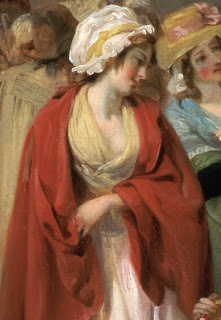As a stop-gap measure, I attached some cheap ribbon to the inside of the center-front edge, right below the seam where the cloak met the hood. This was alright, but it seemed like the wool could give out, given enough time.
A search for period images showing fastening methods in detail turned up ribbons and tapes exclusively. I didn't find any buttons or frogs. Since portraiture is almost exclusively of the upper classes, I found many images of silk cloaks fastening with silk ribbons.
Detail - 1780 Eliz. Crompton by Joseph Wright of Derby, Derby Mus. & Art Gallery
In the above image, it appears that the lining forms a casing through which the (very wide) silk ribbon is drawn. It seems unlikely that wool cloaks could be gathered in the way a silk cloak could due to the thickness and sheer weight of the fabric, but it's an interesting image nevertheless.
Detailed depictions of lower class cloaks are few and far between, with the best-known possibly being Zoffany's The Watercress Girl. I never found a high-res image of the original painting unfortunately, but the low-res shows that the cloak, its edging gimp, and the ties are all the same shade of red. (As an aside, I love this picture for the cloak, spotted handkerchief, beat-up silk-covered hat and horizontal pins!)
Detail - 1780 engraving after Johann Zoffany's Watercress Girl, Yale Cent. for British Art
Detail - Country Woman Selling Ribbons by Francis Wheatley, 1788, wikimedia
(not a great image of the fastening, but you can see her matching ribbon or tape)
Detail - The Fortune Teller by Rev. Matthew Wm. Peters, 1786, unknown source
The above "Fortune Teller" image is intriguing. It looks like it has a pieced (velvet? or self-fabric?) facing over the neck seam. There is a tiny cord or tape evident for tying, though it seems rather short. Perhaps it is a draw-string?
I think I stumbled on the answer I was looking for with this image, though:
Detail - The Market Girl by Henry Walton, 1776, Yale Center for British Art
Judging by how the ribbon seems to come all the way to the edge of the hood or upturned cape before succumbing to gravity and the way it disappeared into the neckline, I began to speculate that the ribbon itself was a facing for the neck seam. This feeling was strengthened by this image which, though late is still plausible since the lady is old:
Detail - An Old Woman Spinning Silk by Margaret Carpenter, 1816, Victoria & Albert Mus.
It looks to me that the ribbon/tape goes all around the neck seam. I put this to the test on my own cloak and found that not only does the ribbon protect the neck from the potentially rough seam and give a neater appearance, but it seems more secure as the weight of the cloak is distributed along the ribbon. I used silk ribbon because I had lined my hood in silk. You can see the improved neatness below on my half-attached ribbon. I'm not saying this is the only way to attach ties, but I think it could be *a* way.
The above image, "An Old Woman Spinning Silk" also brings up another mystery I found when researching cloaks - the ties criss-crossed on the chest. She appears to be wearing a second cape or fichu-like garment under her cloak that fastens with criss-crossed ties disappearing off to who-knows-where. This would seem very odd except...
Detail - One of Paul Sandby's Cries of London, 1759, National Galleries of Scotland
Detail - Female Orators by John Collet, 1768, Lewis Walpole Library
The "Cries" image seems to show the same unusual practice of wearing multiple tied garments, as her cloak is clearly tied in a bow with one of the ends waving in the breeze. The "Female Orators" seems to show a full-length cloak with extra long ties that cross in the front and tie behind her. I can see how this would distribute the weight and allow you to keep your arms free without being choked by the ties. Other examples of this practice can be found in the prints "The Abusive Fruitwoman" and "Billingsgate Triumphant." I think when I make a short cloak, I'll give the long ties a try - nothing like experimental archaeology! If anyone out there has beat me to it, let me know how it worked for you.









Very clever! That would make sense.
ReplyDelete